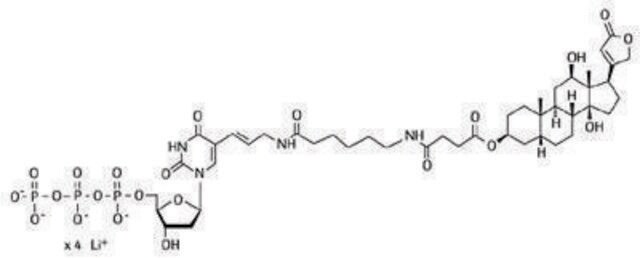11636090910
Roche
PCR DIG Probe Synthesis Kit
sufficient for 25 reaction (50 μL final reaction volume)
Synonym(s):
DIG system, probe
About This Item
usage
sufficient for 25 reaction (50 μL final reaction volume)
Quality Level
manufacturer/tradename
Roche
technique(s)
PCR: suitable
storage temp.
−20°C
General description
The PCR DIG Probe Synthesis Kit contains the Expand High Fidelity DNA polymerase mix. This robust enzyme mix with proofreading activity will polymerize probes 40 bp to 5 kb long using 10 pg plasmid DNA and 10 ng genomic DNA as template. The DIG-labeled probes are stable for over one year.
Application
The concentration of the supplied dUTP-nucleotide mix can be adjusted according to probe length. Labeling effectiveness can quickly be determined on an agarose gel.
Stripping and reprobing of membranes is possible multiple times following the protocol in the package insert.
One PCR labeling reaction (50 μl) will typically yield enough probe for 20 ml hybridization solution. The kit can be used for approximately 25 reactions (50 μl).
Packaging
Quality
Under PCR conditions as described in this package insert, the control reaction generates an amplification product of 442bp. Due to multiple incorporations of DIG-dUTP during the PCR process, the molecular weight of the PCR products is significantly increased compared to the unlabeled PCR product. A specific fragment pattern is detected after hybridization of the PCR product to 10μg human genomic DNA followed by chemiluminescent detection.
Kit Components Only
- Enzyme Mix, Expand High Fidelity 3.5 U/μl
- PCR DIG Probe Synthesis Mix, containing dATP, dCTP, dGTP (2 mM each) 10x concentrated
- PCR Buffer with MgCl2 10x concentrated
- dNTP Stock Solution, containing dATP, dCTP, dGTP, dTTP (2 mM each), pH 7.0 10x concentrated
- Control Template, plasmid DNA in Tris/EDTA buffer, pH 8.0. The 5-kb plasmid contains the cDNA for the human tissue-type plasminogen activator (tPA) 20 pg/μl
- Control PCR Primer Mix, containing 50 pmol of each primer, control PCR primer 1 and 2 2 mM each
also commonly purchased with this product
Hazard Statements
Precautionary Statements
Hazard Classifications
Aquatic Chronic 3
Storage Class Code
12 - Non Combustible Liquids
WGK
WGK 2
Flash Point(F)
does not flash
Flash Point(C)
does not flash
Certificates of Analysis (COA)
Search for Certificates of Analysis (COA) by entering the products Lot/Batch Number. Lot and Batch Numbers can be found on a product’s label following the words ‘Lot’ or ‘Batch’.
Already Own This Product?
Find documentation for the products that you have recently purchased in the Document Library.
Customers Also Viewed
Articles
Digoxigenin (DIG) labeling methods and kits for DNA and RNA DIG probes, random primed DNA labeling, nick translation labeling, 5’ and 3’ oligonucleotide end-labeling.
Our team of scientists has experience in all areas of research including Life Science, Material Science, Chemical Synthesis, Chromatography, Analytical and many others.
Contact Technical Service


